This post was originally published on Eco Watch
The Olympics in Paris this summer could be the hottest on record, according to a new report: Rings of Fire: Heat Risks at the 2024 Paris Olympics. Leading athletes warn the heat could result in athletes collapsing or even dying while participating in events.
Mike Tipton, a human and applied physiology professor at the United Kingdom’s University of Portsmouth, and Dr. Jo Corbett, deputy associate dean for research and innovation in the university’s science and health department, worked with former Olympians and climate scientists to put together the report.
“A warming planet will present an additional challenge to athletes, which can adversely impact on their performance and diminish the sporting spectacle of the Olympic Games. Hotter conditions also increase the potential for heat illness amongst all individuals exposed to high thermal stress, including officials and spectators, as well as athletes,” Corbett said in a press release from University of Portsmouth.
According to the European Union’s Copernicus Climate Change Service, the past 12 months were the hottest on record. As human-driven climate change has led to an entire year of record-breaking monthly temperatures across the globe, athletes in the Games could face serious health risks.
The Olympic Games, which begin on July 26, are scheduled during the hottest two months of the year in Paris.
“For athletes, from smaller performance-impacting issues like sleep disruption and last-minute changes to event timings, to exacerbated health impacts and heat related stress and injury, the consequences can be varied and wide-ranging. With global temperatures continuing to rise, climate change should increasingly be viewed as an existential threat to sport,” said Lord Sebastian Coe, four-time Olympic medallist and president of World Athletics, in the press release.
The authors of the study discuss France’s deadly 2003 heat wave, during which more than 14,000 people perished. They also consider other periods where the country’s mercury soared above 107.6 degrees Fahrenheit.
Paris last hosted the Olympic Games 100 years ago, when the planet’s temperatures were significantly cooler.
“It is a time of great uncertainty and instability. And one of the gravest of those challenges comes from ever-increasing temperatures,” Coe wrote in the report. “There has never been a greater need for heightened awareness, discussion and research into what is happening on the planet and why. Sport is just one part of that, but we cannot be spectators, we must all play a role. We are in a race against time. And this is one race that we simply cannot afford to lose.”
With temperatures above 93.2 degrees Fahrenheit and 70 percent humidity, the 2020 Olympic Games in Tokyo were the “hottest in history,” but the Paris Olympics could be even hotter, the press release said.
“At [the Tokyo Olympics] I felt like the heat was bordering on true risk – the type of risk that could potentially be fatal. One of the best tennis players in the world [Medvedev] said he thought someone might die in Tokyo, and I don’t feel like that was much of an exaggeration… We sometimes have to play in conditions where an egg can literally be fried on the court. This is not fun or healthy. Heatstroke is relatively common in tennis,” said Marcus Daniell, tennis player and Olympic bronze medallist from New Zealand, in the press release.
The report recommends five strategies for sporting authorities to help athletes dealing with extreme heat conditions: scheduling wisely to avoid extreme temperatures; empowering athletes to discuss climate change; fostering collaboration between athletes and sporting bodies regarding climate awareness campaigns; keeping athletes and spectators safe by providing cooling plans and better rehydration; and reassessing the sponsorship of fossil fuels in sports.
“It is not in an athlete’s DNA to stop and if the conditions are too dangerous I do think there is a risk of fatalities,” said Jamie Farndale, a Scottish national rugby sevens player, in the press release.
The report emphasizes the necessity of listening to athletes and prioritizing their safety as the climate crisis continues to heat up.
“Challenges are mounting for athletes regarding air pollution, food and water insecurity and lack of shade. And, as this report makes especially clear, the challenges of climate-change induced extreme heat for athletes are extensive and pose risks of devastating outcomes,” said General Jackson Tuwei, president of Athletics Kenya, in the press release.
The post Heat at Paris Olympic Games Could Put Athletes at Risk, New Report Warns appeared first on EcoWatch.





0 Comments